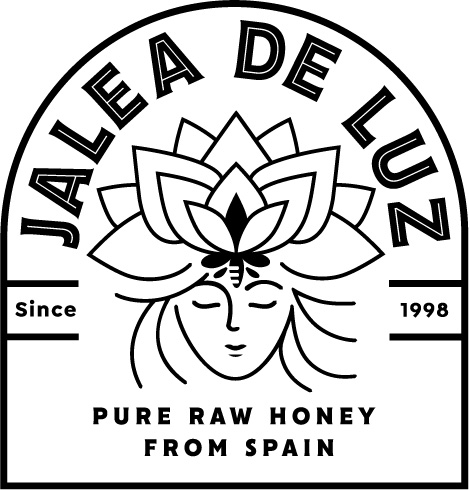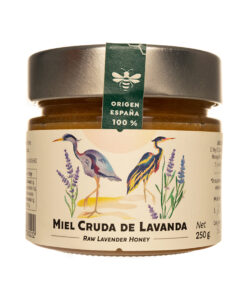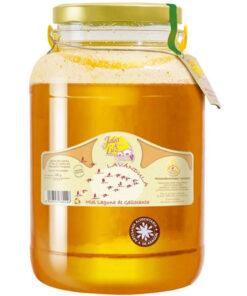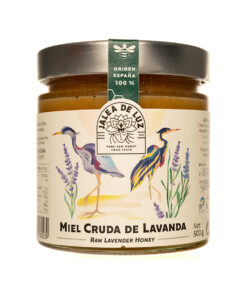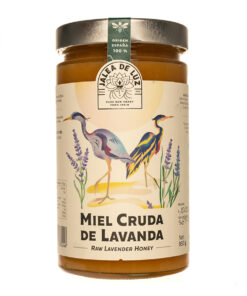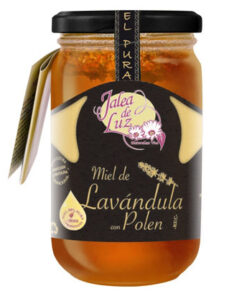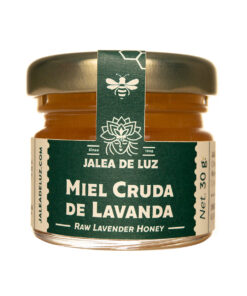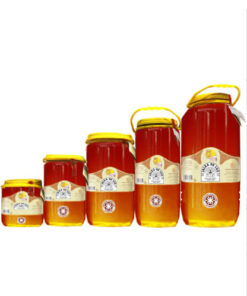Lavender Honey
Origin : Spain and other areas of the Iberian PeninsulaRepresentative species: lavender "Cantueso" (Lavandula Stoechas).
Main floral composition :lavender “Cantueso” (Lavandula Stoechas), thyme (Thymus vulgaris) sometimes seasoned with Hawthorn, marjoram and varied native wild flora.
Production period: summer.
Color : Amber nuanced of different shades.
Flavor : pleasant sweet taste, delicate and intensely floral, with certain acidic notes.
Aroma : very intense, concentrated and persistent, increasing its potency in the retronasal.
Peculiarities: raw honey, pure, not homogenized, not filtered, without added sugars.
Conservation : keep dry, semi-dark and cool.
** In its natural process, honey crystallizes and hardens according to various parameters (temperature, floral origin, etc..).
Characteristics of Lavender Honey
Natural honey mainly from the nectar and pollen of the lavender flower (cantuesus, lavender,..), stands out for its amber color, often nuanced with darker shades if it contains carrasca, thyme, etc ... its consistency is fluid because it tends to crystallize very slowly in fine crystals.It has a pleasant sweet taste, delicate and intensely floral, with certain acidic notes. Its aroma is very intense, concentrated and persistent, increasing its potency in the retronasal. It has high iron content.
Excellencies of Lavender Honey
Like our entire range of our melliferous Hive products (royal jelly, pollen, propolis,..), we describe a traditional natural Lavender Honey collected by our bees in unparalleled places, being protected under the criteria of the products considered first order in the field of the natural:• Raw: has not been subjected to processes of overheating (more than 40 º) or pasteurization, preserving in its entirety the vitamins, nutrients, enzymes and organoleptic qualities typical of a pure unadulterated product.
• Pure: it is produced by bees releasing pollen and nectar from native flowers, and in some cases, secretions of shrub and tree species, and sucking insects, to then proceed to its transformation and storage in the hive; excluding from this process, any factor alien to those that nature itself provides.
• Unfiltered: it is never filtered, to preserve all the natural properties that it has in the storage cells of the hive, thus achieving an excellent natural product without equal.
• Non-homogenized: in our production mode, we never mix natural honeydew from different geographical or floral sources, in order to preserve its original essence and purity.
• No added sugars: our honey remains always pure, just as the bee produces it in the hive, thus containing natural sugars inherent in an unadulterated natural honey.
Usage tips
The natural Lavender Honeys collected by our bees have unique characteristics, being advisable to take them directly, savoring them inside the mouth as long as possible before ingesting them. To make them more manageable in those cases that are preferred diluted, it is recommended at most, warm the "bain-marie" to temperature that never exceeds 40 º to avoid the loss of qualities.Conservation tips
Keep in a dry, semi-dark and cool place to keep all its attributes intact in a natural way.Lavender Honey, where does it come from?
The natural honey of the plant of lavender is produced by bees, as a result of the libation to extract pollen and nectar from the flowers of plant species predominate, such as lavender “toman” (Lavandula Stoechas), lavender (Lavandula angustifolia) and thyme (Thymus vulgaris) are rubbed occasionally with hawthorn, marjoram and wild flora native varied, adding to this sweet floral composition resinous substances a number of shrubby species or trees which are harvested by the pecoreadoras of the hive.As the maximum exponent of this aromatic honey, is the genus Lavandula, being the most representative species of this area the cantuesus, since the lavender occurs in more calcareous areas, which do not coincide in the same space but in nearby areas. We speak of a branched shrub, intensely fragrant with hairy reddish-green stalks, long and long-line greyish leaves, and inflorescences with flowers grouped in final ears, which hold in its dome an amalgam of violet-colored bracts very attractive to bees. It usually blooms during summer.
Lavender Honey, etymology and History
The word “cantuesus "derives from Ancient Greece whose meaning is "ground incense, type of plant"; the lexical components that form it are: khamai (on the ground) and thyos (incense).The name of the genus Lavandula comes from the Latin verb lavo (wash, purify, either lavare-to wash - or livendula-from livid or bluish) and the specific comes from the Greek “stoichas” (aligned, referring to the orderly arrangement of the flowers).
Lavender, like thyme, rosemary.., are native aromatic species of the Mediterranean basin and Macaronesia being also naturalized in Australasia, considering its most remote origin Middle East. For more than 2,500 years, lavender and other varieties of lavender have been used for various purposes for their excellent qualities. Arab, Greek and Phoenician peoples already used these plants in perfumery, cosmetics and mummification processes, while the Romans prepared lavender oils both for culinary purposes and to provide aroma during baths.
There are biblical quotations with its ancient name (”NARD "= from the Greek "naardus"): "then Mary took a pound of pure NARD perfume of much price, and anointed Jesus' feet, and wiped his feet with her hair, and the house was filled with the smell of perfume.", stating even that lavender has its origin in The Times of Adam and Eve. It is also said that the dress of the Child Jesus was impregnated with the smell, when the Virgin Mary put it to dry on a bush of lavender. In many Christian homes, the lavender cross was hung on the door for protective purposes.
Already in medieval and Renaissance Europe, the laundresses also dried clothes on Lavender and lavender bushes, and the monks of the monasteries cultivated it together with a great diversity of native herbs in the so-called"gardens of disease, is worn using lavender and other varieties of lavender ros".
In the ancient manuscripts on “Magic”, lavender and Lavender were well known for their supposed exoteric qualities (in the seventeenth century, the Countess of Dorset of England made her own love potion based on Carnation, Lavender, Bay and marjoram); in the summer fires it was launched by witches as a sacrifice to the ancient goddesses.
Recipes with Lavender Honey
Miscellaneous fruits with Lavender Honey.For this recipe, choose various types of organic fruit such as banana, apple, watermelon, melon and kiwi, varied color and flavor. Wash, remove skin and split into thick pieces all of them.
Place all the fruit in a bowl, apply a little lemon juice and pineapple equal parts, 3 drops of apple vinegar oil, a few crushed mint leaves, 3 to 5 tablespoons of natural aromatic Lavender Honey; stir until flavor homogenize and store in the refrigerator until ready.
It is excellent as a sweet dessert or summer starter, fresh and extraordinarily tasty.
